| Article ID | Journal | Published Year | Pages | File Type |
|---|---|---|---|---|
| 5430294 | Journal of Quantitative Spectroscopy and Radiative Transfer | 2009 | 13 Pages |
When irradiated sideways, by visible light, a particle can perform different kinds of motion, (e.g. in direction of irradiation, opposite to irradiation, vertical movement, helicoidally, etc.). This phenomenon is called photophoresis. Photophoresis is based on momentum transfer between the aerosol particle and surrounding gas molecules. Photophoresis strongly depends on the pressure of the surrounding gas. Particles mostly influenced by photophoresis are those of μm size. Two main types of forces describe photophoretic motion: ÎT force: The thermal accommodation coefficient α is constant over the particle surface. As a result of the thermal accommodation, gas molecules on the warm side of a particle leave the surface faster than gas molecules on the cold side. This leads to ÎT force on the particle towards the colder side. Typical motion of the particle will be either away from light irradiation (positive photophoresis), or in direction of light irradiation (negative photophoresis). In the case of negative photophoresis, the back side of the particle, due the nature of light absorption, will be heated more than front side of the particle. Îα force: If the particle is at a constant temperature, which is different from the temperature of the surrounding gas, and the thermal accommodation coefficient α varies over the particle surface, the net momentum between gas molecules and particle will be transferred. In this case, the result will be body fixed Îα force. Depending on the particle surface properties, Îα force can direct the particle in any possible photophoresis could also play important role in planet formation and astrophysics.
